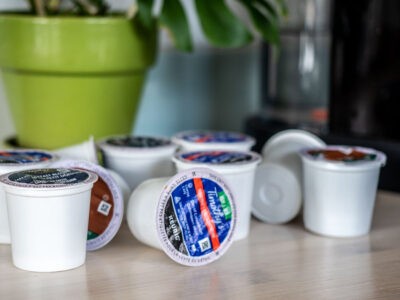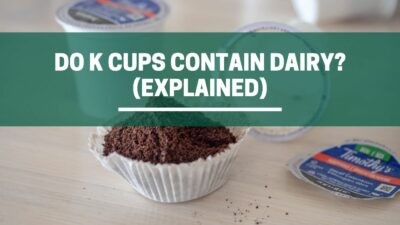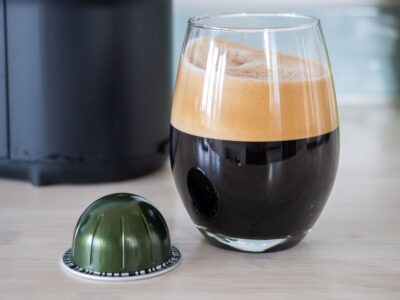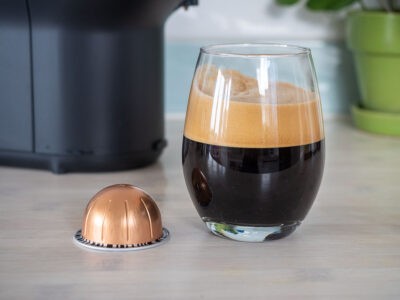Coffee 101, Coffee Health
How Much Caffeine Is In 10 Grams Of Coffee Beans? (Caffeine Per Gram Explained)
Whether you’re looking to increase or decrease the caffeine content in your cup of coffee, having an idea of just how much caffeine you’re consuming is always good practice.
Many factors affect the amount of caffeine in coffee beans. These include the type of coffee, the temperature of the water you’re using, how coarse or fine you grind your beans, the origin, the brewing method you use, and the brew ratio. A typical 10 grams of Arabica coffee beans will have roughly 100 mg of caffeine, and Robusta beans will have about 220 mg. But, this amount is not standard across all the cups you drink.
This article discusses each of these in detail, so you can better understand your caffeine intake with every cup you drink.
Why Listen To Us? Well, because we KNOW coffee! In fact, we make our own coffee, coffee machine cleaners, and reusable capsules which we've sold to over 41 countries. Our team ouf experts include Tristan (an engineer), Claire (a food writer) and Richy (a barista). So, whether you're looking for a recipe or repair guide, we've got you covered 💚
Table of Contents
How Much Caffeine Is There In Coffee Beans?
The table below summarises the amount of caffeine in the main type of coffee beans, together with the number of beans in grams.
| Coffee Bean/(mg) | Arabica | Robusta |
|---|---|---|
| 1g | 10mg | 22mg |
| 5g | 50mg | 110mg |
| 7g | 70mg | 154mg |
| 10g | 100mg | 220mg |
| 15g | 150mg | 330mg |
| 20g | 200mg | 440mg |
| 100g | 1000mg | 2200mg |
What Factors Contribute To The Caffeine Content Of Coffee?
Coffee is not all the same, so the amount of caffeine you get will differ from cup to cup. Several factors influence caffeine content. Here’s an explanation of each of them.

1. Variety/Species
Arabic and Robusta are the most common varieties of coffee beans. But they vary in caffeine composition. Robusta has more caffeine than Arabica due to its chemical composition and processing conditions. The approximate difference between the two is that Robusta contains 1.8 to 2 times more caffeine than Arabica.
2. Origin
The environment where the coffee beans are sourced from plays a major role in the caffeine content. Arabica grown in Kenya and Ethiopia is known to produce coffee beans with low caffeine content compared to those grown in Brazil. Likewise, Robusta grown in Vietnam is likely to produce less caffeine than that grown in Uganda.
Robust thrives in areas where it receives a lot of sunlight, yet Arabica produces adequate caffeine when grown in shady areas. Altitude also determines how much caffeine lands in your cup. Coffee beans grown at an altitude of about 1200m above sea level generally produce beans with a higher caffeine level compared to those grown at 1000m above sea level.
Did you know: Conventionally grown coffee generally has more caffeine compared to its organic counterpart because the nitrogen in the fertilizer increases the caffeine content?
3. Light vs. Dark Roast
Contrary to popualr belief, both light and dark roasts have the same amount of caffeine.
The only difference is the weight by volume between the two. up to 90% of the weight of green beans is lost during roasting. The longer the roast master roasts the beans, the more water each bean loses its water content, therefore, making it less dense. Darker roasts are roasted longer to achieve a deep brown color and to increase their bitterness.
Because of this, dark roast are less dense compared to the light roast. For the weight of the dark toasted beans to be equivalent to the light roast, you’d add more of the dark roasted beans, which results in high caffeine content. This is how people got the notion that dark roasts have more caffeine than light roasts.
In fact, the density between light and dark coffee beans can vary as much as 29% (source). If you measue your coffee by volume, e.g. a scoop of coffee, then this means youll get less caffeine with a dark roast. If you measure your coffee by weight, then the caffeine will be exactly the same between roasts (source)
4. Grinding Degree
There are generally four degrees of grind: coarse, medium, fine, and very fine, but also meany sizes in between. A fine grind is often the sweet spot for brewing most types of coffee because it has a larger surface area for the beans to interact with the water.
This interaction allows all the caffeine, coffee aromas, and flavors to be extracted to give you the best brew. But, it is also worth noting that a coarse grind can give you the same results as a fine one if you let it steep longer.
5. Coffee/ Water Ratio
The more coffee you pour into the brewing device you’re using, the more caffeine you’ll likely get. The less coffee you pour, the less caffeine.
6. Water temperature
Caffeine is a water-soluble substance, even more so in hot water. Cold water generally slows down the extraction of caffeine in a brew, which is why a cold brew is either left to brew a little longer than the other coffee types, or has more coffee added to it. So, the ideal water temperature for caffeine extraction is between 176-205℉ (80-96℃).
How Different Brewing Methods Affect The Caffeine Content
There are two main techniques for brewing coffee: infusion and percolation. Infusion includes the likes of French press and Aeropress methods, and percolation encompasses the pour-over and drip techniques. These brewing methods do determine whether or not you’ll get a super, under, or moderately caffeinated cup of joe.
Because the amount of caffeine differs according to the varieties of beans used, most of the time you’ll get an estimate of how much caffeine to expect. For this post, we’ll give a breakdown of how brewing methods affect the caffeine count in your cup based on lightly roasted Arabica coffee beans.
Here’s an explanation of how much caffeine you’ll get per 8-ounce of coffee from each of these methods.
1. French press
The French press method of extracting caffeine depends on constantly infusing the coffee beans in water as opposed to the water passion through the beans. This allows for all the caffeine to dissolve. The longer the grounds steep in the water, the higher the caffeine. A French press gives you up to 100 mg of caffeine.
2. Aeropress
The Aeropress technique relies on brewing grounds for up to 2 minutes. Similar to the French press, this is enough time for water to extract caffeine from the beans without over-caffeinating your drink. You can expect up to 70mg of caffeine from this brew.
3. Pour over/Drip
Whether you decide to use the drip or pour-over method, both these techniques require water to slowly filter through the grounds. For this reason, and the steady brew time, medium-fine ground beans are used which gives enough time for the water to filter through each ground. For this method, you can expect up to 100mg of caffeine.
4. Coffee Machine
Coffee beans brewed in coffee machines are often finely ground. This increases the surface area of the beans, resulting in more water-to-coffee contact, thus more caffeine extraction. You can expect to get up to 126mg of caffeine from this method.
Frequently Asked Questions
Q. How much caffeine is in a gram of coffee beans?
The standard amount of caffeine you’ll get from a gram of coffee is 10mg. But, this also depends on the variety of coffee beans. Arabica generally has about 10 mg of caffeine per gram of beans, while Robusta has about 22mg of caffeine per gram.
Conclusion
If you’ve been on the lookout for your caffeine intake – whether to increase or decrease the content, this post is a good place to start. While we’d like to tell you every cup of coffee you brew has the same caffeine content, it’s not always the case. The amount of caffeine in coffee beans varies.
A few of the contributing factors are variety, origin, water temperature, grind size, and brew ratio. But, a typical gram of Arabica coffee beans has about 10 mg of caffeine, and Robusta has 22 mg of caffeine.







